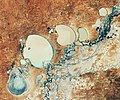File:Menindee Lakes Finally Refilling.jpeg
Jump to navigation
Jump to search

Size of this preview: 720 × 600 pixels. Other resolutions: 288 × 240 pixels | 576 × 480 pixels | 922 × 768 pixels | 1,229 × 1,024 pixels | 1,810 × 1,508 pixels.
Original file (1,810 × 1,508 pixels, file size: 3.55 MB, MIME type: image/jpeg)
File history
Click on a date/time to view the file as it appeared at that time.
| Date/Time | Thumbnail | Dimensions | User | Comment | |
|---|---|---|---|---|---|
| current | 00:20, 25 May 2021 |  | 1,810 × 1,508 (3.55 MB) | commons>StellarHalo | {{Information |Description=For the first time in five years, Australia’s Menindee Lakes are brimming with water. The lakes are a series of nine large, shallow depressions that hold water supplies for the nearby towns of Menindee and Broken Hill, located about 110 kilometers (70 miles) away. The water is also used for irrigation and domestic purposes on the lower Darling River. The images above show the series of Menindee Lakes during summer on February 2, 2019 (right), and during the fall on... |
File usage
There are no pages that use this file.

